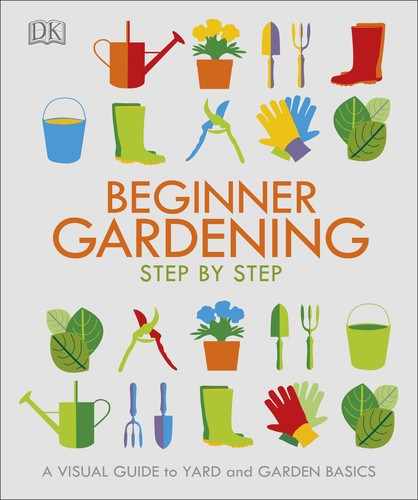
JARGON BUSTER
Softwood cuttings are the soft
and pliable young shoots of a plant
or shrub.
Woodier cuttings are taken from
slightly thicker, woody stems.
Aerial roots are roots that form
above the ground.
Water sprouts are new shoots that
spring up directly from the roots.
1
In late summer, select a nonflowering
shoot 3–4 in (7.5–10 cm) long from a
healthy-looking plant. Try to avoid any
stems that are too young and soft as
these are more dicult to root.
GROWING HERBS
FROM CUTTINGS
Many plants do not produce viable seed or, if they do,
it is so fussy or slow to grow that it is easier and
quicker to take cuttings from your favorite plant.
Always keep your new cuttings moist and in a warm,
sunny place.
YOU WILL NEED
• cuttings from plants, e.g., rosemary,
camomile, thyme, mint
• small plant pots and cell trays
• small pruners or scissors
• fine potting soil
• vermiculite
• watering can with fine spray nozzle
SEE ALSO
• HERBS FROM SEED >> 198/201
• AN HERB GARDEN >> 204/205
• DIVIDING HERBS >> 214/215
SOFTWOOD CUTTINGS
US_210-211_GrowingHerbsCuttings.indd 210 07/09/2018 16:35

HERBS // GROWING HERBS FROM CUTTINGS 210–211
CONTINUED
Use your ngertips
to feel for the
knobby leaf node
that holds leaves
on a plant
3
Insert the cutting 1
1
/4–1
3
/4 in (3–4 cm) deep
into a 50:50 vermiculite and fine soil mix. If
the cutting bends too easily, it is too young or
the soil is too coarse. Water well.
2
Cut just below a leaf node using clean,
sharp pruners and remove the leaves
from the bottom half of the cutting. Prepare
one cutting at a time so it does not dry out
and deteriorate.
Clear any debris
from the potting
soil, such as small
twiggy strands
CONTINUED
US_210-211_GrowingHerbsCuttings.indd 211 07/09/2018 16:35

WOODIER CUTTINGS
1
Select a firm, slightly woody,
nonflowering side shoot 2–4 in
(5–10 cm) long and gently cut or pull
it away from the main stem so a
sliver of bark remains on the cutting.
2
Trim any wispy strands from
the heel and carefully remove all
the leaves from the lower half. Insert
the cutting into a 50:50 vermiculite
and fine soil mix. Water well.
Look carefully at the underside of
herbs such as camomile and thyme
and you will see aerial roots growing
from their stems. These stems will
develop happily if detached and
grown on in their own plug or pot.
1
For herbs with invasive roots, such as mint, divide
the parent plant into good-sized portions with
large fleshy roots for potting up individually. Do
not reuse the old potting soil.
LAZY CUTTINGS
3
Cut a section 2–2
3
/4 in
(5–7 cm) long, with at least
one node. Insert vertically into
your potting mix. Consider
growing more than is needed
to insure against loss.
2
Select a long, healthy,
firm root with a
diameter of at least
1
/4 in
(5 mm). Look for knobby
structures (nodes), which
appear at intervals and
may already be sprouting
new roots and shoots.
ROOT CUTTINGS
US_212-213_GrowingHerbsCuttings2.indd 212 07/09/2018 16:35

HERBS // GROWING HERBS FROM CUTTINGS 212–213
Pinch out parts that
are leaning over or
looking untidy to
leave behind the
strongest growth
2
Cut just above a leaf node
into segments 2¾–4 in
(7–10 cm) long and insert four or
five into each small pot, so at
least one pair of small young
leaves is above the surface.
Sometimes there
may not be adequate
cutting material
available. New side
shoots will grow
quickly if the top
2–4 in (5–10 cm) are
pinched out. These
shoots might make
good cuttings.
1
Remove water sprouts from container
plants—they root if they touch bare
soil. Keep one or two for cuttings, but
dispose of the rest carefully; they grow
well on the compost heap.
PROPAGATING MINT SUCKERS
PINCHING OUT
US_212-213_GrowingHerbsCuttings2.indd 213 07/09/2018 16:35
..................Content has been hidden....................
You can't read the all page of ebook, please click here login for view all page.
